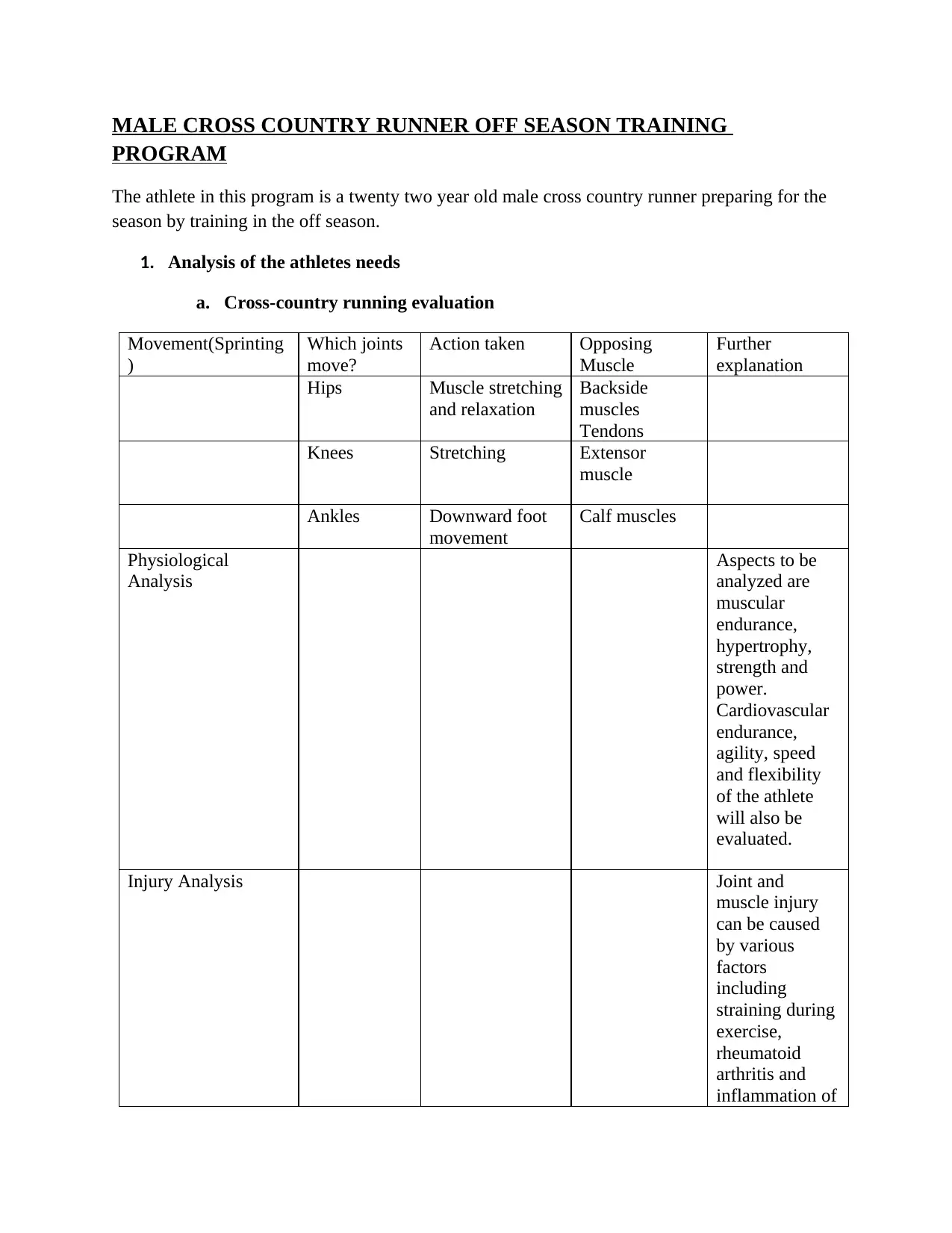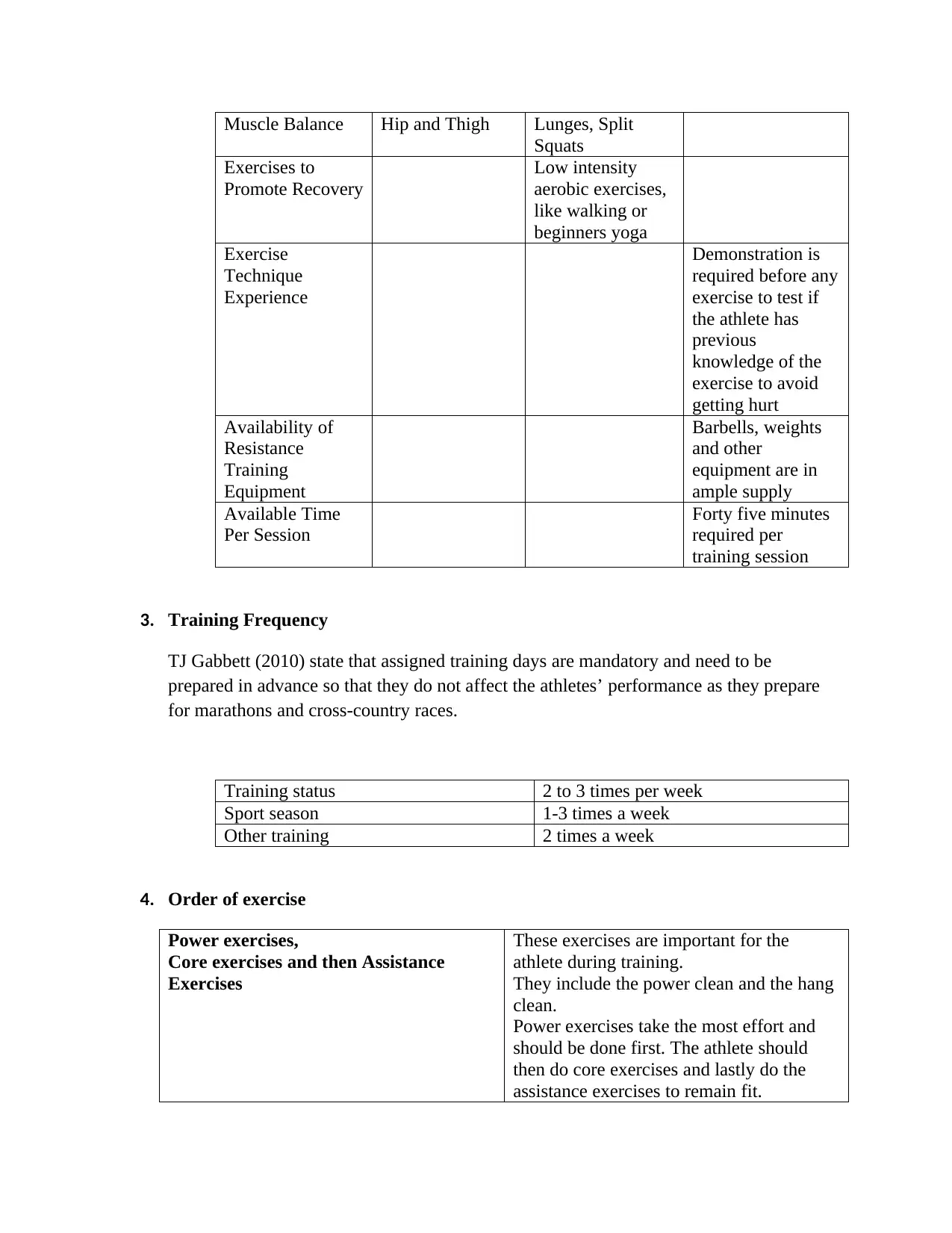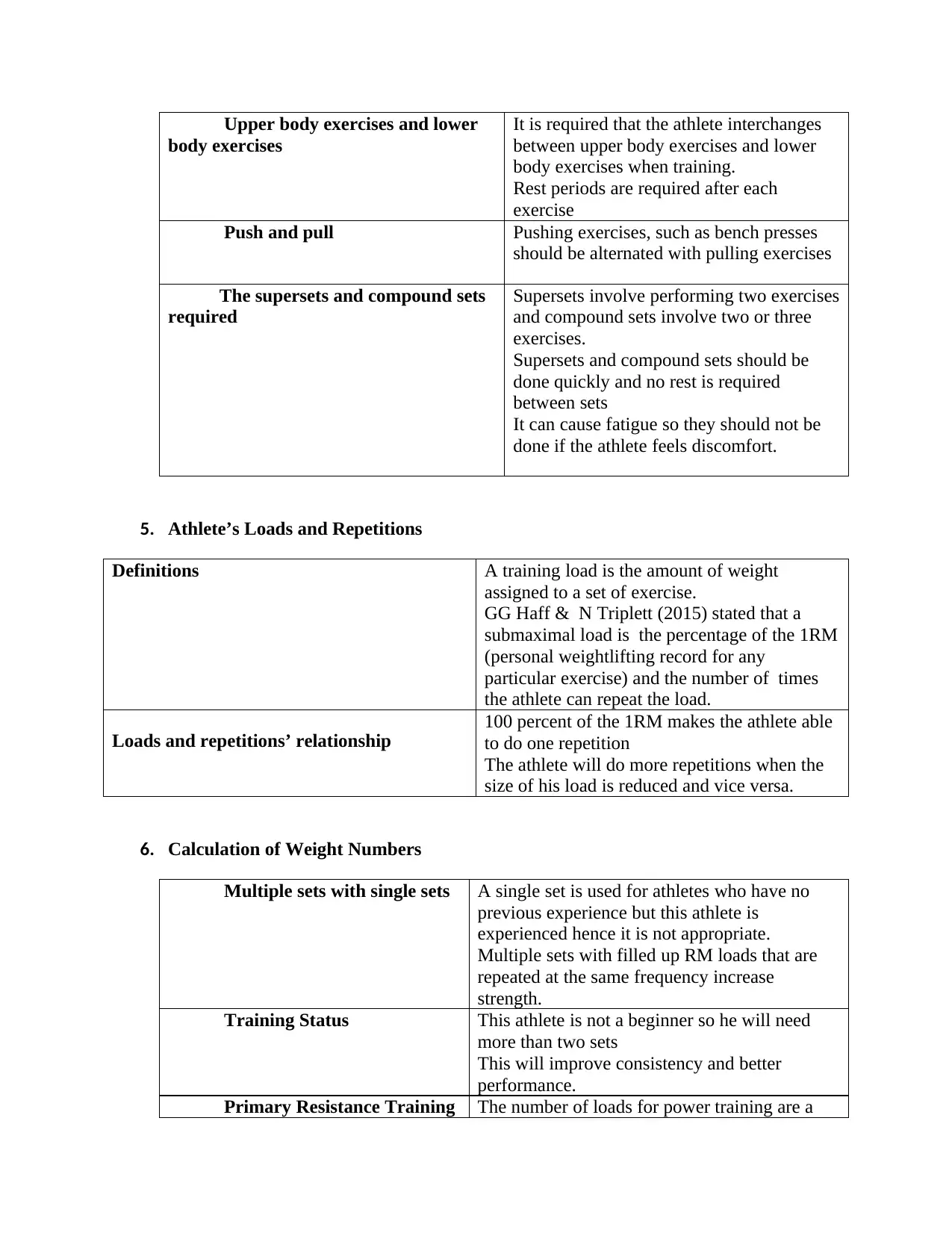Detailed Off-Season Training Program for a Male Cross Country Runner
VerifiedAdded on 2021/11/16
|6
|1058
|38
Report
AI Summary
This report outlines an off-season training program specifically designed for a twenty-two year old male cross country runner. It begins with an analysis of the athlete's needs, evaluating movement patterns, and identifying key joints and muscles involved in running. A physiological analysis assesses muscular endurance, hypertrophy, strength, power, cardiovascular endurance, agility, speed, and flexibility. The program includes an injury analysis, considering potential causes and preventative measures. The report then details the athlete's training status, including practice and weight training frequencies across different seasons. It also covers testing and evaluation procedures, exercise selection, and techniques, as well as the availability of equipment and session time constraints. The core of the program focuses on exercise order, rest periods, and the application of supersets and compound sets. The report also defines training loads, repetitions, and their relationship, providing a comprehensive guide to maximizing the athlete's performance. References to relevant research support the program's methodology.

MALE CROSS COUNTRY RUNNER OFF SEASON TRAINING
PROGRAM
The athlete in this program is a twenty two year old male cross country runner preparing for the
season by training in the off season.
1. Analysis of the athletes needs
a. Cross-country running evaluation
Movement(Sprinting
)
Which joints
move?
Action taken Opposing
Muscle
Further
explanation
Hips Muscle stretching
and relaxation
Backside
muscles
Tendons
Knees Stretching Extensor
muscle
Ankles Downward foot
movement
Calf muscles
Physiological
Analysis
Aspects to be
analyzed are
muscular
endurance,
hypertrophy,
strength and
power.
Cardiovascular
endurance,
agility, speed
and flexibility
of the athlete
will also be
evaluated.
Injury Analysis Joint and
muscle injury
can be caused
by various
factors
including
straining during
exercise,
rheumatoid
arthritis and
inflammation of
PROGRAM
The athlete in this program is a twenty two year old male cross country runner preparing for the
season by training in the off season.
1. Analysis of the athletes needs
a. Cross-country running evaluation
Movement(Sprinting
)
Which joints
move?
Action taken Opposing
Muscle
Further
explanation
Hips Muscle stretching
and relaxation
Backside
muscles
Tendons
Knees Stretching Extensor
muscle
Ankles Downward foot
movement
Calf muscles
Physiological
Analysis
Aspects to be
analyzed are
muscular
endurance,
hypertrophy,
strength and
power.
Cardiovascular
endurance,
agility, speed
and flexibility
of the athlete
will also be
evaluated.
Injury Analysis Joint and
muscle injury
can be caused
by various
factors
including
straining during
exercise,
rheumatoid
arthritis and
inflammation of
Paraphrase This Document
Need a fresh take? Get an instant paraphrase of this document with our AI Paraphraser

cushioning
pads.
b. Assessment of Athlete
Training status Off season
Practice-low, weight training-high
Preseason
Practice-medium, weight training-
medium
During the season
Practice-high, weight training-low
Testing and evaluation of physical
needs
According to E Enoksen, AR Tjelta&
LI Tjelta (2011), the athlete will need to
go for a full physical evaluation to
determine if he is at risk of any physical
injury and if he has any illnesses that
might affect his workouts and his
performance during off-season training.
Primary resistance training goal Goal- fitness
2. Exercise Selection
Exercise Type Joints involved Exercise Futher explanation
Core and
Assistance
Exercises
Chest, hip and
thigh
Upper arm,
abdominal
muscles
Jumping
Weight lifting
Bench presses
Front and back
squats
Lunges
Structural and
Power Exercises
Hip, chest, arm,
spine
Power cleans
Barbell back squat
Movement
involved in cross
country running
Cross country
exercises
Arms, Legs,
Hips, Thighs
Jumping, Rope
skipping and
Running because
the sport is
running for
marathoners
pads.
b. Assessment of Athlete
Training status Off season
Practice-low, weight training-high
Preseason
Practice-medium, weight training-
medium
During the season
Practice-high, weight training-low
Testing and evaluation of physical
needs
According to E Enoksen, AR Tjelta&
LI Tjelta (2011), the athlete will need to
go for a full physical evaluation to
determine if he is at risk of any physical
injury and if he has any illnesses that
might affect his workouts and his
performance during off-season training.
Primary resistance training goal Goal- fitness
2. Exercise Selection
Exercise Type Joints involved Exercise Futher explanation
Core and
Assistance
Exercises
Chest, hip and
thigh
Upper arm,
abdominal
muscles
Jumping
Weight lifting
Bench presses
Front and back
squats
Lunges
Structural and
Power Exercises
Hip, chest, arm,
spine
Power cleans
Barbell back squat
Movement
involved in cross
country running
Cross country
exercises
Arms, Legs,
Hips, Thighs
Jumping, Rope
skipping and
Running because
the sport is
running for
marathoners

Muscle Balance Hip and Thigh Lunges, Split
Squats
Exercises to
Promote Recovery
Low intensity
aerobic exercises,
like walking or
beginners yoga
Exercise
Technique
Experience
Demonstration is
required before any
exercise to test if
the athlete has
previous
knowledge of the
exercise to avoid
getting hurt
Availability of
Resistance
Training
Equipment
Barbells, weights
and other
equipment are in
ample supply
Available Time
Per Session
Forty five minutes
required per
training session
3. Training Frequency
TJ Gabbett (2010) state that assigned training days are mandatory and need to be
prepared in advance so that they do not affect the athletes’ performance as they prepare
for marathons and cross-country races.
Training status 2 to 3 times per week
Sport season 1-3 times a week
Other training 2 times a week
4. Order of exercise
Power exercises,
Core exercises and then Assistance
Exercises
These exercises are important for the
athlete during training.
They include the power clean and the hang
clean.
Power exercises take the most effort and
should be done first. The athlete should
then do core exercises and lastly do the
assistance exercises to remain fit.
Squats
Exercises to
Promote Recovery
Low intensity
aerobic exercises,
like walking or
beginners yoga
Exercise
Technique
Experience
Demonstration is
required before any
exercise to test if
the athlete has
previous
knowledge of the
exercise to avoid
getting hurt
Availability of
Resistance
Training
Equipment
Barbells, weights
and other
equipment are in
ample supply
Available Time
Per Session
Forty five minutes
required per
training session
3. Training Frequency
TJ Gabbett (2010) state that assigned training days are mandatory and need to be
prepared in advance so that they do not affect the athletes’ performance as they prepare
for marathons and cross-country races.
Training status 2 to 3 times per week
Sport season 1-3 times a week
Other training 2 times a week
4. Order of exercise
Power exercises,
Core exercises and then Assistance
Exercises
These exercises are important for the
athlete during training.
They include the power clean and the hang
clean.
Power exercises take the most effort and
should be done first. The athlete should
then do core exercises and lastly do the
assistance exercises to remain fit.
⊘ This is a preview!⊘
Do you want full access?
Subscribe today to unlock all pages.

Trusted by 1+ million students worldwide

Upper body exercises and lower
body exercises
It is required that the athlete interchanges
between upper body exercises and lower
body exercises when training.
Rest periods are required after each
exercise
Push and pull Pushing exercises, such as bench presses
should be alternated with pulling exercises
The supersets and compound sets
required
Supersets involve performing two exercises
and compound sets involve two or three
exercises.
Supersets and compound sets should be
done quickly and no rest is required
between sets
It can cause fatigue so they should not be
done if the athlete feels discomfort.
5. Athlete’s Loads and Repetitions
Definitions A training load is the amount of weight
assigned to a set of exercise.
GG Haff & N Triplett (2015) stated that a
submaximal load is the percentage of the 1RM
(personal weightlifting record for any
particular exercise) and the number of times
the athlete can repeat the load.
Loads and repetitions’ relationship
100 percent of the 1RM makes the athlete able
to do one repetition
The athlete will do more repetitions when the
size of his load is reduced and vice versa.
6. Calculation of Weight Numbers
Multiple sets with single sets A single set is used for athletes who have no
previous experience but this athlete is
experienced hence it is not appropriate.
Multiple sets with filled up RM loads that are
repeated at the same frequency increase
strength.
Training Status This athlete is not a beginner so he will need
more than two sets
This will improve consistency and better
performance.
Primary Resistance Training The number of loads for power training are a
body exercises
It is required that the athlete interchanges
between upper body exercises and lower
body exercises when training.
Rest periods are required after each
exercise
Push and pull Pushing exercises, such as bench presses
should be alternated with pulling exercises
The supersets and compound sets
required
Supersets involve performing two exercises
and compound sets involve two or three
exercises.
Supersets and compound sets should be
done quickly and no rest is required
between sets
It can cause fatigue so they should not be
done if the athlete feels discomfort.
5. Athlete’s Loads and Repetitions
Definitions A training load is the amount of weight
assigned to a set of exercise.
GG Haff & N Triplett (2015) stated that a
submaximal load is the percentage of the 1RM
(personal weightlifting record for any
particular exercise) and the number of times
the athlete can repeat the load.
Loads and repetitions’ relationship
100 percent of the 1RM makes the athlete able
to do one repetition
The athlete will do more repetitions when the
size of his load is reduced and vice versa.
6. Calculation of Weight Numbers
Multiple sets with single sets A single set is used for athletes who have no
previous experience but this athlete is
experienced hence it is not appropriate.
Multiple sets with filled up RM loads that are
repeated at the same frequency increase
strength.
Training Status This athlete is not a beginner so he will need
more than two sets
This will improve consistency and better
performance.
Primary Resistance Training The number of loads for power training are a
Paraphrase This Document
Need a fresh take? Get an instant paraphrase of this document with our AI Paraphraser

Goal smaller number as compared to those for
strength training to maximize the quality of the
exercise
Hypertrophy involves a higher number
associated with increase in muscle size.
Three to six sets per exercise will be required
For muscular endurance, performing many
repetitions will be required.
For strength and power, long rest periods will
be required especially for structural exercises.
This will improve the athletes performance
7. Rest Periods
Training goal Rest interval Length Recovery between
workouts
Strength and Power 3-5 minutes 48- 72 hours
Hypertrophy 30-90 seconds 24-72 hours
Muscular Endurance 30-45 seconds 24 hours
References
Haff, G.G., & Triplett, N. (2015). ESSENTIALS OF STRENGTH TRAINING AND
CONDITIONING 4TH EDITION-books.google.com
Gabbett, T.J. (2010).THE DEVELOPMENT AND APPLICATION OF AN INJURY
PREDICTION MODEL FOR NON-CONTACT, SOFT-TISSUE INJURY IN ELITE
COLLISION SPORT ATHLETES- The Journal of Strength &Conditioning Research -
journals.lww.com
Enoksen, E., Tjelta, A.R., & Tjelta, L.I. (2011). Distribution of training volume and
intensity of elite male and female track and marathon runners-journals.sagepub.com
Stray-Gundersen, J., & Chapman, R.F. (2011). “Living high-training low” altitude
training improves sea level performance in male and female elite runners…Journal of
applied- physiology.org
Beattie, K., Carson, B.P., & Lyons, M. (2017). The effect of strength training on
performance indicators in distance runners…The Journal of.., -journals.lww.com
Aagaard, P., & Andersen, J.L. (2010). EFFECTS OF STRENGTH TRAINING ON
ENDURANCE CAPACITY IN TOP-LEVEL ENDURANCE ATHLETES…, journal of
medicine and science in..- wiley online library
strength training to maximize the quality of the
exercise
Hypertrophy involves a higher number
associated with increase in muscle size.
Three to six sets per exercise will be required
For muscular endurance, performing many
repetitions will be required.
For strength and power, long rest periods will
be required especially for structural exercises.
This will improve the athletes performance
7. Rest Periods
Training goal Rest interval Length Recovery between
workouts
Strength and Power 3-5 minutes 48- 72 hours
Hypertrophy 30-90 seconds 24-72 hours
Muscular Endurance 30-45 seconds 24 hours
References
Haff, G.G., & Triplett, N. (2015). ESSENTIALS OF STRENGTH TRAINING AND
CONDITIONING 4TH EDITION-books.google.com
Gabbett, T.J. (2010).THE DEVELOPMENT AND APPLICATION OF AN INJURY
PREDICTION MODEL FOR NON-CONTACT, SOFT-TISSUE INJURY IN ELITE
COLLISION SPORT ATHLETES- The Journal of Strength &Conditioning Research -
journals.lww.com
Enoksen, E., Tjelta, A.R., & Tjelta, L.I. (2011). Distribution of training volume and
intensity of elite male and female track and marathon runners-journals.sagepub.com
Stray-Gundersen, J., & Chapman, R.F. (2011). “Living high-training low” altitude
training improves sea level performance in male and female elite runners…Journal of
applied- physiology.org
Beattie, K., Carson, B.P., & Lyons, M. (2017). The effect of strength training on
performance indicators in distance runners…The Journal of.., -journals.lww.com
Aagaard, P., & Andersen, J.L. (2010). EFFECTS OF STRENGTH TRAINING ON
ENDURANCE CAPACITY IN TOP-LEVEL ENDURANCE ATHLETES…, journal of
medicine and science in..- wiley online library

⊘ This is a preview!⊘
Do you want full access?
Subscribe today to unlock all pages.

Trusted by 1+ million students worldwide
1 out of 6
Related Documents
Your All-in-One AI-Powered Toolkit for Academic Success.
+13062052269
info@desklib.com
Available 24*7 on WhatsApp / Email
![[object Object]](/_next/static/media/star-bottom.7253800d.svg)
Unlock your academic potential
Copyright © 2020–2025 A2Z Services. All Rights Reserved. Developed and managed by ZUCOL.





